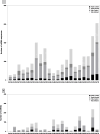Noncoding elements in wheat defence response to fusarium head blight
- PMID: 40307260
- PMCID: PMC12043830
- DOI: 10.1038/s41598-025-00067-6
Noncoding elements in wheat defence response to fusarium head blight
Abstract
Wheat (Triticum aestivum L.) is a major source of global food security while various stressors, including biotic and abiotic factors, directly affect its production. Among these stressors, Fusarium infection poses a significant risk, leading to severe yield losses, and compromising the overall quality of the crop. To understand the regulatory mechanisms modulating wheat's response against Fusarium Head Blight (FHB) stress, a comprehensive analysis of the noncoding RNA profiles of two wheat varieties, Vida and Hank, was conducted. A dataset has been generated utilizing high throughput RNA sequencing (RNAseq) and small RNA sequencing (sRNAseq) technologies for identifying and characterizing microRNA (miRNA) and long noncoding RNA (lncRNA) profiles of these cultivars and the changes upon Fusarium infection. Our analysis revealed not only common but also cultivar- and condition-specific miRNAs and lncRNA transcripts, showing the unique regulatory responses exhibited by these wheat varieties under Fusarium stress. Furthermore, the functional properties of the identified miRNAs were investigated by identifying their putative coding sequence (CDS) targets. Additionally, the regulatory relationships between the putative miRNAs and lncRNAs were explored, providing a view of the complex molecular networks coordinating wheat's response against Fusarium infection. The proposed regulatory network includes the dynamic interplay between miRNAs, CDS targets, and lncRNAs, offering insights into potential key players in the adaptive responses of wheat to biotic stressors.
Keywords: Fusarium; Long noncoding RNA; MicroRNA; Noncoding; Wheat.
© 2025. The Author(s).
Conflict of interest statement
Competing interests: The authors declare no competing interests.
Figures





Similar articles
-
Comparative transcriptomes reveal insights into different host responses associated with Fusarium head blight resistance in wheat.BMC Plant Biol. 2025 Apr 22;25(1):509. doi: 10.1186/s12870-025-06553-3. BMC Plant Biol. 2025. PMID: 40259243 Free PMC article.
-
Genome-Wide Identification and Characterization of Fusarium graminearum-Responsive lncRNAs in Triticum aestivum.Genes (Basel). 2020 Sep 27;11(10):1135. doi: 10.3390/genes11101135. Genes (Basel). 2020. PMID: 32992604 Free PMC article.
-
Jasmonate and ethylene dependent defence gene expression and suppression of fungal virulence factors: two essential mechanisms of Fusarium head blight resistance in wheat?BMC Genomics. 2012 Aug 2;13:369. doi: 10.1186/1471-2164-13-369. BMC Genomics. 2012. PMID: 22857656 Free PMC article.
-
Quantitative Genetics of Disease Resistance in Wheat.Curr Issues Mol Biol. 2018;27:105-108. doi: 10.21775/cimb.027.105. Epub 2017 Sep 8. Curr Issues Mol Biol. 2018. PMID: 28885177 Review.
-
Germplasms, genetics and genomics for better control of disastrous wheat Fusarium head blight.Theor Appl Genet. 2020 May;133(5):1541-1568. doi: 10.1007/s00122-019-03525-8. Epub 2020 Jan 3. Theor Appl Genet. 2020. PMID: 31900498 Review.
References
-
- World Health Organization. UN Report: Pandemic year marked by spike in world hunger (2021).
-
- United Nations. The Sustainable Development Goals Report 2023 (2023).
-
- Melissa Shipman, S. W. Just 15 Crops Provide 90% of the World’s Food Energy Intake (2021).
-
- FAO The role. Of Agriculture in Global Food Security. In Food and Agriculture Organization of the United Nations (2024).
-
- Grote, U., Fasse, A., Nguyen, T. T. & Erenstein, O. Food security and the dynamics of wheat and maize value chains in Africa and Asia. Front. Sustain. Food Syst.4, 56 (2021).
MeSH terms
Substances
LinkOut - more resources
Full Text Sources

